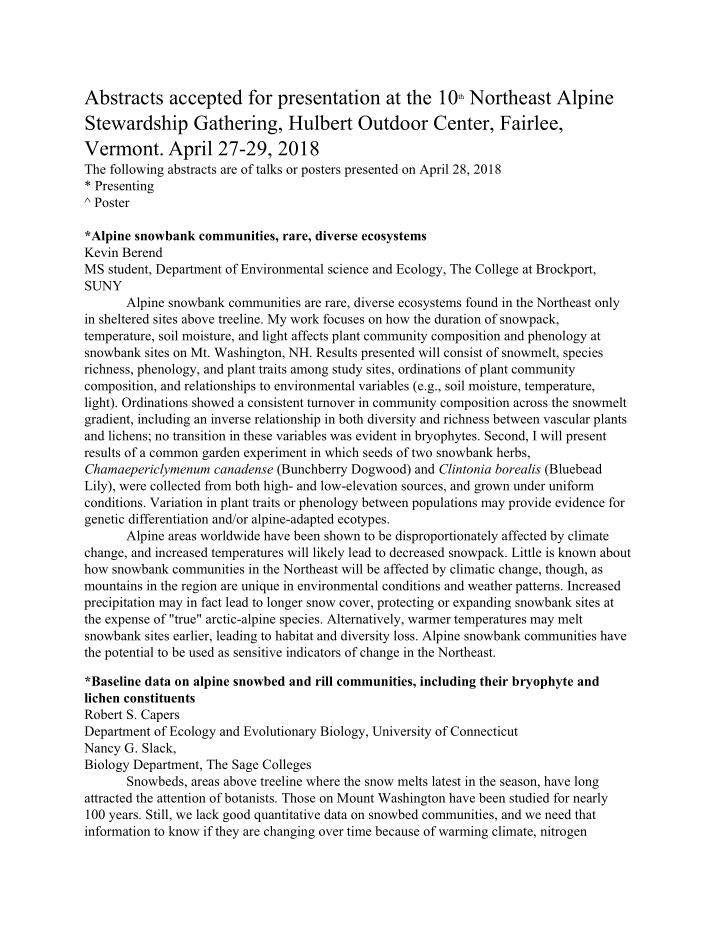



Abstracts accepted for presentation at the 10 th Northeast Alpine Stewardship Gathering, Hulbert Outdoor Center, Fairlee, Vermont. April 27-29, 2018 The following abstracts are of talks or posters presented on April 28, 2018 * Presenting ^ Poster *Alpine snowbank communities, rare, diverse ecosystems Kevin Berend MS student, Department of Environmental science and Ecology, The College at Brockport, SUNY Alpine snowbank communities are rare, diverse ecosystems found in the Northeast only in sheltered sites above treeline. My work focuses on how the duration of snowpack, temperature, soil moisture, and light affects plant community composition and phenology at snowbank sites on Mt. Washington, NH. Results presented will consist of snowmelt, species richness, phenology, and plant traits among study sites, ordinations of plant community composition, and relationships to environmental variables (e.g., soil moisture, temperature, light). Ordinations showed a consistent turnover in community composition across the snowmelt gradient, including an inverse relationship in both diversity and richness between vascular plants and lichens; no transition in these variables was evident in bryophytes. Second, I will present results of a common garden experiment in which seeds of two snowbank herbs, Chamaepericlymenum canadense (Bunchberry Dogwood) and Clintonia borealis (Bluebead Lily), were collected from both high- and low-elevation sources, and grown under uniform conditions. Variation in plant traits or phenology between populations may provide evidence for genetic differentiation and/or alpine-adapted ecotypes. Alpine areas worldwide have been shown to be disproportionately affected by climate change, and increased temperatures will likely lead to decreased snowpack. Little is known about how snowbank communities in the Northeast will be affected by climatic change, though, as mountains in the region are unique in environmental conditions and weather patterns. Increased precipitation may in fact lead to longer snow cover, protecting or expanding snowbank sites at the expense of "true" arctic-alpine species. Alternatively, warmer temperatures may melt snowbank sites earlier, leading to habitat and diversity loss. Alpine snowbank communities have the potential to be used as sensitive indicators of change in the Northeast. *Baseline data on alpine snowbed and rill communities, including their bryophyte and lichen constituents Robert S. Capers Department of Ecology and Evolutionary Biology, University of Connecticut Nancy G. Slack, Biology Department, The Sage Colleges Snowbeds, areas above treeline where the snow melts latest in the season, have long attracted the attention of botanists. Those on Mount Washington have been studied for nearly 100 years. Still, we lack good quantitative data on snowbed communities, and we need that information to know if they are changing over time because of warming climate, nitrogen
deposition, or changes in the amount or timing of precipitation. We surveyed five snowbeds and four rill communities, recording the presence and abundance of vascular plants, which had been studied previously, as well as bryophytes and lichens, which had been incompletely documented in snowbeds and rills. We found 54 vascular plant species, 42 bryophytes and 13 lichens. Although vascular plants were most abundant, bryophytes and lichens were important in terms of species richness (as many as eight bryophytes and four lichens in 1 m 2 quadrats) and were occasionally abundant, particularly bryophytes in rills. Our surveys provide baseline information on snowbeds and rill communities so future studies can determine how they respond to changes in environmental conditions. *Tree seedling recruitment, growth and survival above treeline on Mount Moosilauke: Seven years of surveys Robert S. Capers Department of Ecology and Evolutionary Biology, University of Connecticut Little is known about how trees recruit to the tree-free area we know as the alpine. How many tree seedlings establish, how quickly do they grow, how long do they survive? What we really want to know is whether trees are surviving longer and growing faster now than they did in the past, but the data we would need to answer those questions are lacking. The best we can do now is get the baseline information so someone can come back in 30 or 40 years and determine if the seedlings are doing better or worse. Only then will know whether the trees will be able to survive where they can’t now, creating a forest on what is the tree-free alpine and eliminating the alpine plants that can’t survive under a closed canopy. I report here on seven years of surveys on tree seedling recruitment, growth and survival on Mount Moosilauke. I can’t answer the questions we care most about, but I can provide the baseline information so those questions can be answered in the future. *Forty years of hiker damage, trail management, and rehabilitation on Franconia Ridge Charlie Cogbill The Franconia Ridge Trail (a segment of the Appalachian Trail) has been the site of the most intense and comprehensive studies of trail management and hiker impact of any alpine trail in the world. Informal photographs since the 1860s have documented the results of expansion of the trail from only ascending the summit of Mount Lafayette to then traversing the entire ridge south to Little Haystack. In 1975 the AMC surveyed the trail, photographed 62 trail segments, established 32 cross trail transects, and planned for reconstruction of the trail. The trail was reconstructed and well defined in 1977 using scree walls, stone steps, waterbars, cairns, blazing, and grading the treadway. From 1977 to 1980 Peter Marchand established 12 sites to test the effects of transplanting, seeding, natural revegetation, fertilization, terracing, and gardening along the abandoned trail. These revegetation efforts were renewed in 1988-1991 by the USFS using alien seeding and mechanical cover of the most degraded sites. In 1989 Joe Doucette of the AMC followed up resampling 13 of the 1975 cross-trail transects and retaking 50 to the trail segment photographs. Charles Cogbill working under a USFS contract in 1993 sampled the previous experimental sites and established 11 semi-permanent vegetation transects. Last summer (2017) Cogbill, working under a USFS contract with Beyond Ktaadn, re-photographed all 62 1975 trail segments; resampled Marchand revegetation plots; resampled and marked 9 of the 1993 vegetation transects; and resampled 10 of Doucette’s cross-trail transects. Collation,
Recommend
More recommend